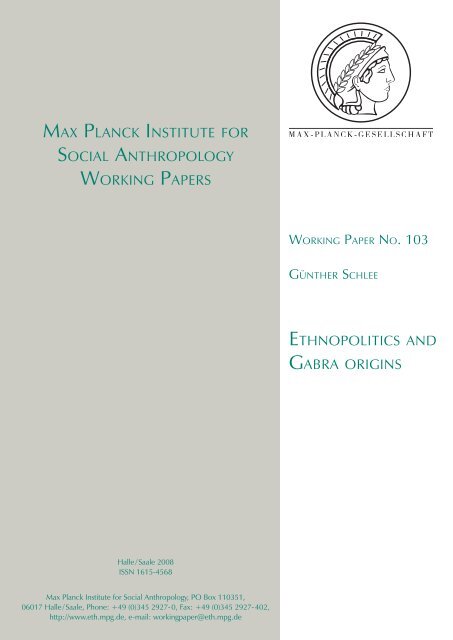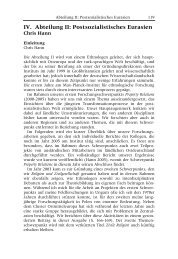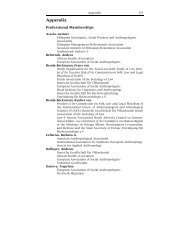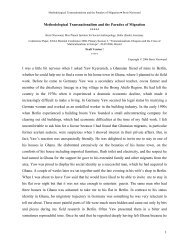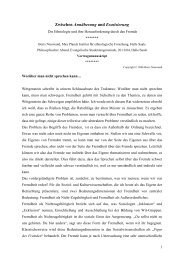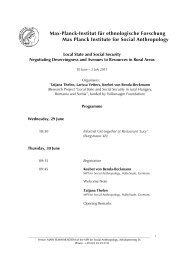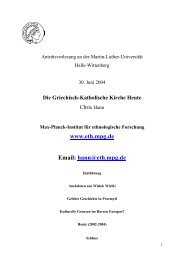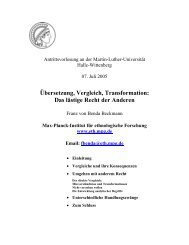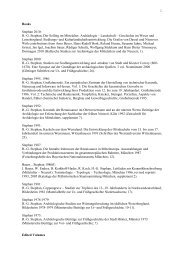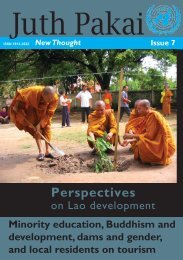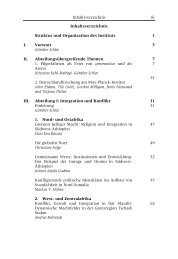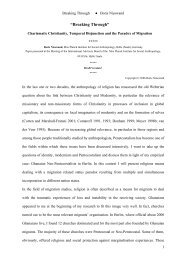ETHNOPOLITICS AND GAbRA ORIGINS - Max-Planck-Institut für ...
ETHNOPOLITICS AND GAbRA ORIGINS - Max-Planck-Institut für ...
ETHNOPOLITICS AND GAbRA ORIGINS - Max-Planck-Institut für ...
You also want an ePaper? Increase the reach of your titles
YUMPU automatically turns print PDFs into web optimized ePapers that Google loves.
<strong>Max</strong> <strong>Planck</strong> InStItute for<br />
SocIal anthroPoloGy<br />
WorkInG PaPerS<br />
Halle / Saale 2008<br />
ISSN 1615-4568<br />
<strong>Max</strong> <strong>Planck</strong> <strong>Institut</strong>e for Social Anthropology, PO Box 110351,<br />
06017 Halle / Saale, Phone: +49 (0)345 2927- 0, Fax: +49 (0)345 2927- 402,<br />
http://www.eth.mpg.de, e-mail: workingpaper@eth.mpg.de<br />
WorkInG PaPer no. 103<br />
Günther Schlee<br />
ethnoPolItIcS and<br />
Gabra orIGInS
Ethnopolitics and Gabra origins 1<br />
Günther Schlee 2<br />
Abstract<br />
Historical anthropology has turned from a specialist and slightly old-fashioned research interest<br />
into a hotly contended field of study. Ethnogenesis, i.e. the way in which ethnic groups have<br />
evolved out of earlier such configurations, has been incorporated into the discourse of ethnic<br />
activists. The present paper deals with reconstructions of the past by Aneesa Kassam, who in turn<br />
bases her arguments to a substantial degree on Gemetchu Megerssa’s statements. It confirms some<br />
of her findings and elaborates on them. Some of her main points, however, which deal with the<br />
degree to which the present day Gabra can be derived from the Boran Oromo, are found to be at<br />
variance with other evidence. The question is raised whether her perspective is influenced by<br />
modern Oromo nationalism or individual Oromo nationalists. On a more general level, the paper<br />
touches the question to which extent it is possible to write “factual” history. The ambition is to<br />
establish at least a skeleton of fact on which intersubjective agreement can be reached and which<br />
can be contrasted against interest-guided versions of history or ideological distortions.<br />
1<br />
I thank Paul Baxter, Brian Donahoe, Dereje Feyissa, Christina Echi Gabbert, and Jan Hultin for their<br />
helpful comments on the draft of this paper.<br />
2<br />
Günther Schlee, <strong>Max</strong> <strong>Planck</strong> <strong>Institut</strong>e for Social Anthropology, Halle/Saale, Germany, Halle/Saale,<br />
Germany, PO Box 110357, 06017 Halle/Saale; Phone: (+49)-(0)345 2927-100 Fax: (+49)-(0)345 2927-102,<br />
email: schlee@eth.mpg.de
In the 2006 winter issue of Ethnohistory, Aneesa Kassam put forth an argument about the origins<br />
of the Gabra that she claimed was at odds with the version I had presented in my 1989 monograph,<br />
Identities on the Move. The journal gave me the opportunity to respond to her criticism. My word<br />
limit was 4,000, and another 2,000 would be allowed to Aneesa Kassam to respond to my response.<br />
My comment was printed in the 2008 spring issue of Ethnohistory (Schlee 2008). For reasons<br />
unknown to me, no reply by Kassam was included. I found my own comment – in its brevity –<br />
unsatisfactory for two reasons: (1) there was no space to deal with the complexities of interwoven<br />
ethnogenetic processes, which are in the shared focus of Kassam’s and my own work, and (2) I was<br />
forced to be highly selective in my presentation and decided to concentrate on the points which<br />
appeared controversial, leaving out many observations which were in basic agreement with<br />
Kassam’s findings, just adding one or the other detail. In its brevity, my criticism of Kassam may<br />
in some places have sounded harsher than it was intended. I therefore already announced in said<br />
article that I would publish a fuller version as a Working Paper to be put on the web, and that is<br />
what the present paper is meant to be. Another unsatisfactory element is that this dialogue threatens<br />
to become one-sided. In this paper I keep the conversation going in the hope that one day Kassam<br />
will respond.<br />
In what follows, I demonstrate that Kassam’s position is much more in agreement with mine than<br />
she wants to acknowledge, which is borne out by the fact that much of the evidence she presents as<br />
new was already presented in my monograph (and later publications). I suppose she went to such<br />
lengths to emphasise the differences between our positions, because she has been biased by sources<br />
with political agendas that are not supported by my interpretation of the historical record.<br />
When I began to do field research among the Gabra in 1978, having completed a monographic<br />
study 3 on the neighbouring Rendille (Schlee 1979), and moving on to trace interethnic<br />
relationships, no one had had any doubts that the Gabra were Oromo, or “Galla” as the older<br />
literature read. They speak the Boran dialect of Oromo and have been politically and ritually<br />
affiliated with the Boran in many ways, apparently for centuries. They were among those<br />
Haberland called “vassals” of the Boran (1963: 141).<br />
Collecting clan and lineage histories, I then found that the vast majority of the Gabra did not<br />
claim Oromo origins. Some did, and in the book resulting from this research (Schlee 1989) I also<br />
faithfully recorded those. But in far more cases the clan origins pointed either to relatively recent<br />
immigration from Rendille-dominated regions, or to an earlier Rendille-like population which<br />
bestowed a complex of cultural features also on groups that today speak Somali dialects 4 , and<br />
which I therefore called the Proto-Rendille-Somali (PRS) complex. At the core of the PRS complex<br />
are a calendar and a set of rules regarding camels. The two are interrelated since a main concern of<br />
the PRS, and all northern Kenyan lowland pastoralists deriving from them, is what to do with<br />
camels on which day, both in terms of ritual and practical matters (a distinction they themselves do<br />
not make). Therefore, the vast majority of the Gabra must at one point of their history have<br />
3 In the sense of a monoethnic monograph, a framework I later wanted to break up.<br />
4 Rendille itself would have been classified as a Somali dialect if it had been found to be spoken by people<br />
inside Somalia and not so far west, in Kenya, separated from their closest linguistic relatives by a belt of<br />
Oromo speakers.<br />
2
undergone a language shift from a Somaloid language to Oromo 5 . Some are also said to have had<br />
Samburu (Maa speakers) connections or to have yet other origins (Schlee 1989: 166, 170). But the<br />
bulk clearly derived from people who at one point spoke a language of the Somali cluster.<br />
This finding, surprising as it was against the background of assumed purely Oromo origins of the<br />
Gabra that had never been questioned by anyone, must have impressed people a lot. The book<br />
(which does not just deal with Gabra origins but also with matters of more theoretical interest 6 ) was<br />
kindly received and widely cited. Now, seventeen years later, Aneesa Kassam (2006) has devoted a<br />
long and detailed article to proving that the Gabra are not of exclusively Somali-like derivation, but<br />
also have important Oromo connections. The discourse seems to have come full circle. In the<br />
1980s, everyone would have wondered what else the Gabra should be, if not Oromo.<br />
Although it is sweetened with some elements of praise, the basic plot of her argument consists of<br />
building me up as an adversary. She starts her paper by explaining what she takes to be my position<br />
on Gabra origins and she ends by refuting it. She succeeds in radicalising the difference between<br />
that position and her own (described as new) by a highly selective reading of my book and by<br />
totally ignoring the rest of my work, although much of it is perfectly accessible in respected book<br />
series and journals in the language and country where Aneesa Kassam is at home<br />
(English/England). But even if one limited the discussion to a comparison of my book and her<br />
article, one would find that the Oromo links of the Gabra and the regional perspective she<br />
advocates and presents as new 7 are all there in my book already. This reduces the difference<br />
between her position and mine to a question of degree. Are the Gabra to a higher degree Oromo<br />
and to a lesser degree 8 shaped by their PRS 9 origins than I have asserted in my 1989 book? Neither<br />
5 Somali (and its variants: Rendille, Maymay, standard (northern) Somali, Tunni, etc.) and Oromo both<br />
belong to the Lowland branch of Eastern Cushitic and show structural similarities like similar forms of verbal<br />
derivations, a fact which greatly facilitated my learning Oromo on the basis of Rendille. However, phonetics<br />
and the lexicon are sufficiently different from each other to make mutual comprehension between<br />
monolinguals completely impossible. They do not just differ on the dialect level but are clearly different<br />
languages.<br />
6 The main focus lies on interethnic clan relationships, not just between Rendille and Gabra, but also<br />
extending to Sakuye, Garre and Ajuran Somali. Some authors have taken up this idea and addressed the issue<br />
of how far this network of interrelationships extends east to other Somali, or whether similar relationships of<br />
cross-cutting clans and lineages exist there independently (Luling 2002, Helander 2003). Others have been<br />
inspired by it to look for clan relationships between major units elsewhere, both close by, as among Maasai<br />
(Spear and Waller 1993) and the Burji (Amborn 1998), and further afield, as among the Ndebele (Lindgren<br />
2004), Hopi (Shetler 1996), and Uzbeks (Finke 2005). On a more abstract level, one can read the book as one<br />
on the dynamics of cross-cutting relationships. As such, it has been taken up by Firat (1997) in her<br />
description of identity games among Kurds and Turks, where these ethnic classifications cross-cut religious<br />
ones (Sunni, Alevi, etc.), in a manner similar to that in which ethnicity and clanship cross-cut in northern<br />
Kenya and people can situationally choose whether to identify along ethnic or religious lines. Pelican (2006)<br />
applies the model on a similar level to the Cameroon Grassfields.<br />
7 The title of a section of her paper, Toward a Regional Interpretation (Kassam 1996: 185), suggests that this<br />
perspective is new and in contrast to earlier work.<br />
8 Questions of degree should not lead us to forget questions of kind. Before the recent massacres, many<br />
Gabra may have stressed their linguistic and political closeness to the Boran, but they might have been more<br />
afraid of spilling Somali blood than of spilling Boran blood, because they believed their “blood” to be the<br />
same as that of the Somali and they believed the misfortune resulting from killing Somali to be disastrous<br />
(Schlee 1994b on ethnobiological categories).<br />
9 Here I slightly restate the assumed difference, because the way Kassam phrases it makes little sense:<br />
“[Schlee’s] theoretical construct of the PRS, which excludes the Boran and portrays them in a hegemonic<br />
role, simplifies the complex social, political, economic, and ritual relations which existed between the<br />
different groups. It does not correspond to the views of the Boran oral historians of and relationships between<br />
the groups” (Kassam 2006: 176–7). As explained above, the PRS cultural complex is defined by features<br />
relating to camels on one side and a particular calendar on the other. It can be found among the camel<br />
keeping lowlanders whom the Boran call worr dasse – “people of the mat [-covered tents]”. The Boran focus<br />
3
in my own research experience since 1989, nor in anything written by others, including Aneesa<br />
Kassam’s article, have I found a shred of evidence for this. I could therefore brush her criticism<br />
away by saying that it is partly superfluous (to the extent that she just reiterates me), and partly<br />
wrong (where she actually appears to differ, namely in her implications about degrees of Oromoness).<br />
Such a summary dismissal would, however, not do Aneesa Kassam justice, who has worked on<br />
the Gabra for decades and who should be encouraged to contribute pieces to the complex mosaic of<br />
ethnohistory in northern Kenya and southern Ethiopia, where many questions still need to be<br />
answered. To do so in a cooperative way, and to abstain from radicalising dichotomies and from<br />
building straw men just for setting them ablaze, would be more conducive to this effort. I will<br />
therefore try to be constructive and address the issues she raises on the level of ethnographic detail.<br />
Much of the evidence I am going to adduce perfectly supports the relevance of the Oromo links<br />
Aneesa Kassam emphasises, but it stems from materials collected and findings published long ago<br />
and does not induce me to now tip the balance of the Oromo and Somali influences on the Gabra<br />
toward the Oromo side. Ethnohistory in this setting has been a highly politicised matter, at least<br />
since the introduction of the “Galla” [Oromo]/Somali line as a territorial boundary in the early<br />
British colonial period, and has been even more so since the intense ethnicisation of Kenyan<br />
politics in the Moi period (1978 to 2002) and the demise of the Mengistu regime in Ethiopia in<br />
1991. Ethnicity then became the principle underlying the regional order of Ethiopia. Who is an<br />
“Oromo” and who a “Somali” is not only a hotly debated question, but one fought out with guns<br />
from time to time. Therefore, questions of how to identify the influence of political ideologies on<br />
historical reconstructions, and how to present one’s findings in such a way that they are not easily<br />
oversimplified and appropriated by political activists or even entrepreneurs of violence, also need<br />
to be addressed. Unfortunately, Aneesa Kassam seems to have accepted a high-level player in<br />
Ethiopian ethnic politics as her key informant rather uncritically 10 .<br />
Kassam (p. 176) claims that my analysis, which “simplifies the complex social, political,<br />
economic, and ritual relations that existed historically between the different groups (...) does not<br />
correspond to the views of Boran oral historians on the origins and relationships between the<br />
groups.” Having written hundreds of pages of detailed accounts about all these matters, I do not<br />
plead guilty to such a multiple simplification. Still it may be legitimate to ask who the Boran oral<br />
on cattle and have a not less elaborate, but quite different, calendar. They certainly would not feel “excluded”<br />
by not being subsumed under the PRS. On the contrary, they might feel offended if they were. The groups<br />
sharing the PRS complex all speak or once spoke a Somali-like language, i.e. they belong or belonged to the<br />
Omo-Tana branch of the Lowland East Cushitic languages. Oromo, the language of the Boran, is also<br />
Lowland East Cushitic, but not Omo-Tana. (For the benefit of the specialists, I will come back to details of<br />
linguistic classification in footnote 26. All this is well known; in my writings I have mentioned this wider<br />
linguistic affiliation shared by the bearers of the PRS complex and the Boran, and I have described centuries<br />
of interactions between all these groups. So I have in no way excluded the Boran from my analysis, and to<br />
exclude them from the category PRS is the obvious thing to do and cannot be a point of accusation. I will<br />
address other elements of this argument (“hegemony”, “simplification”, “Boran oral historians”) below.<br />
10 She cites Gemetchu Megerssa six times, three times with his unpublished London doctoral dissertation,<br />
twice with a personal communication, and once with a publication written jointly with her. Gemetchu<br />
Megerssa, an Oromo from Wollega, has at various stages of his life been a researcher for the<br />
priest/anthropologist Lambert Bartels (Bartels 1983), the chairman of an Oromo association (the Macha<br />
Tulama Association), vice chancellor of the University of Addis Abeba, and a political agent in the present<br />
government crisis after the contested 2005 elections. My assessment of his scholarly qualifications has been a<br />
matter of public record for a long time (Schlee 1997: 134f, 2003: 352).<br />
4
historians are, who provide a less simplistic view. On this issue, Jan Hultin (personal<br />
communication) offers the following observations:<br />
“A. K. mentions (notes, p. 190) interviews with two Boran oral historians. One of them (or<br />
both of them?) lives in Nairobi. (...) I have heard of one of them, Dabassa Guyo. When I was<br />
in Nairobi the other year, two Oromo from Wollega told me about a ‘Hayyu Debessu<br />
Guyoo’ who, according to them and what I jotted down in my notebook, is ‘teaching Oromo<br />
history, culture, religion, everything. Dr. Gemetchu was here for many years learning from<br />
him. He lives at the last stop of busses number 1 and 2. He was Gemetchu’s main source.<br />
Many foreigners are learning from him. He is teaching every day throughout the week. You<br />
pay 500 shillings per month for his teaching. He is teaching in small groups, foreigners in<br />
one group etc. He is not a rich man.’<br />
Now, this may be gossip and rumours. But that is not the point. The point is that if<br />
anthropologists use the same sources (elders, experts, oral historians etc.) this creates<br />
problems that deserve to be discussed. These are the problems [reminiscent] of the ones dealt<br />
with by Lyn Schumaker in her book Africanizing Anthropology (2001). And if the ‘local<br />
experts’, ‘elders’, hayyu, or whatever increase their reputation because anthropologists and<br />
other foreigners regard them (or thereby make them) experts, this may create some<br />
epistemological problems (how are these sources influenced by such contact; how are they –<br />
the oral historians etc. – ‘inherited’ by anthropologists; not to speak of how they are<br />
influenced by teaching as gurus to new age romantics and what not).<br />
I suppose there may be other Boran ‘oral historians’ further to the north, in northern Kenya<br />
and Ethiopia. As it is now, the section on A Perspective from Boran Oral Tradition (pp. 182–<br />
185 et pas.) seems to be based mainly on the two persons mentioned in notes on p. 190 – and<br />
on Gemetchu.” (personal communication with Jan Hultin)<br />
To base one’s conclusions on the views of authorities may be a questionable procedure anyhow,<br />
and to base them on questionable authorities, which do not even seem to be sources independent of<br />
each other, is an even more questionable method. I prefer to compare many sources of different<br />
kinds, check their internal consistency and that with each other, and then to come to my own<br />
conclusions.<br />
I shall now address some ethnographic questions in the order of her presentation. This implies<br />
that some of my comments are related to her central thesis, others not.<br />
Kassam (2006: 173) calls the Gabra phratries (“the five drums”) semi-exogamous. I would call<br />
them largely endogamous. Without having figures, I would claim that most marriages are entered<br />
into within a phratry. This has to do with the spatial separation Kassam mentions. Marriage is often<br />
entered into with the other moiety (Jiblo/Yiblo versus Lossa) within a phratry. These moieties<br />
might therefore be called semi-exogamous. Tendencies towards exogamy at the moiety level,<br />
could, by the way, have been linked to wider (early, only partly persisting) Oromo patterns, in<br />
support of her emphasis on Oromo links.<br />
The religious chants of the Gabra contain non-Oromo words. Kassam (2006: 174) is right on this<br />
and also on pointing to Sufi influences. In fact, the name of the chants, dikira, is derived from<br />
5
dhikr, the Arabic word for “commemoration,” which is the word Sufis use to refer to their chants.<br />
In her footnote, referring to these chants, she explains that “[t]he Borana state that the idiom of the<br />
Gabra religious elders is the same as that spoken at their own ritual centres” (fn. 4, p.190). The<br />
dabela (religious elders) of the Gabra may indeed have a special vocabulary shared by the<br />
gadamoji of the Boran. The context, however, seems to suggest that some or all of this sameness<br />
extends to the language of the dikira chants. If this was the case, it would pose an interesting riddle:<br />
While this ritual language, called Af Daiyo by the Gabra, is full of Arabic elements, the examples I<br />
present (1989: 70f) also contain Cushitic roots 11 shared by Oromo, Somaloid, and other languages,<br />
which more clearly point to the Somali side. One word of ultimately Arabic derivation (sher from<br />
shari’a, the law, the path) is used there in the Rendille sense of seer – “day of the week” 12 – rather<br />
than in the Boran sense (seera- “law”). If the Boran Oromo used that type of language, it would<br />
point to a greater importance of non-Oromo elements in the culture of the Boran themselves than is<br />
usually assumed.<br />
In some places, Kassam has not fully exploited the Boran links of the cultural domains she<br />
describes. Her description of the sites, to which the Gabra phratries undertake their ritual journeys<br />
on the occasion of age set promotions, agrees with mine (Schlee 1989: 135, 1992a: 111ff), and also<br />
her description of the sequence of these pilgrimages, with Gaar, the senior phratry, being the first,<br />
is correct. What she fails to mention is that to trigger the whole chain of events a heifer must be<br />
given by the Boran to the Gaar. The Boran thereby are given the ritual privilege of setting the time<br />
for these events (which in fact is largely determined by the calendar 13 ) and are accorded the seniormost<br />
position of all (Schlee 1998: 130). This makes perfect sense in view of the role they played as<br />
the centre of the Worr Libin alliance, comprising the Gabra, Sakuye, and other basically PRSderived<br />
camel nomads prior to the arrival of the British (Schlee 1989: 37–41).<br />
Such interconnections of cultural systems, however, cannot be interpreted in terms of origins.<br />
Mutual interdependence between the many different gada (generation set) systems of the area<br />
seems to have been a means towards political integration of a wider region. The Boran themselves,<br />
who today are seen as prototypical Oromo traditionalists and who also in their history have often<br />
been in opposition to groups who professed Islam, need a banner (baqala faaji), given to them by<br />
Garre Somali (Schlee and Shongolo 1995: 15, Schlee 1998: 140), and the material for the turbans<br />
(duubo) of the Galbo ritual elders (dabela) is brought by a Sheqaal Somali who receives a fixed<br />
payment, i.e. a ritual gift, of a young camel bull (gurbo) in return (Schlee 1998: 139). Still, in view<br />
of the emphasis Kassam puts on Boran links, it came as a surprise to me how many such links she<br />
failed to notice, even though they could easily have been extracted from my published works.<br />
Kassam presents a “regional” perspective as an alternative to my interpretation of history and in<br />
contrast to my description of the Worr Libin alliance. I think, however, that my description does fit<br />
the characterisation as ‘regional’. This alliance had the main qallus 14 , hereditary ‘priests’, of the<br />
11<br />
The term ‚roots’ here is used in the linguistic sense of basic shapes, which can be traced back to earlier<br />
forms in neighbouring or ancestral languages.<br />
12<br />
Another sense of seer in Rendille would be “boundary.”<br />
13<br />
These rituals can only take place in certain months, each part of them on a given day, after an interval of at<br />
least two seven-year cycles.<br />
14<br />
Kassam writes qaalluu. One also finds qallu and qaalu. In my view this is a case of compensatory<br />
lengthening. Speakers who simplify the ll to l compensate this by lengthening the a to aa. This means that the<br />
word should be written either with a double aa or with a double ll, not with both letters duplicated. The<br />
lengthening of final vowels often has to do with flexion or emphasis, i.e. with the function a word has in a<br />
sentence. In these cases the lengthening should be omitted when the word is cited in isolation.<br />
6
Boran as its two ritual centres, the gada system of the Boran as a time giver for periodic<br />
pilgrimages to the Boran and as the core of a joint politico-military alliance that comprised many<br />
groups of PRS origin, some of whom had adopted the Oromo language, others of whom had<br />
remained bilingual or continued to prefer Somaloid dialects 15 . My account comprises all these<br />
different peoples rather than focusing on one of them, precisely because it is ‘regional’ in character.<br />
These remarks do not exhaust the importance of gada institutions for interethnic relations. To<br />
enrich Kassam’s “regional” perspective it should also be mentioned that, apart from modern type<br />
Muslim Somali, all former member groups of the Worr Libin alliance have gada systems, with the<br />
five Gabra Malbe phratries alone having three markedly different ones. But the fact that they all<br />
have gada systems is a true regional phenomenon. This observation, however, says nothing about<br />
whether the Gabra are more Oromo or more Somaloid. My analysis (Schlee 1989: 73–90) shows<br />
that generation set systems of the gada type are common heritage to all speakers of Lowland East<br />
Cushitic (or even East Cushitic) languages, and have not recently been borrowed by one branch<br />
from the other 16 . As remnants show, the Somali also may have had a gada system, and dropped it<br />
in the course of Islamisation 17 .<br />
Kassam makes a great deal of those Gabra lineages, which are of Boran origin, although these are<br />
a numerical minority. One of her prime examples is the Berre lineage of the Alganna phratry<br />
(Kassam 2006: 178). I render a Gabra account of the Boran origin of this lineage as well, slightly<br />
longer, but basically agreeing with Kassam’s version (Schlee 1989: 200). Kassam (ibid.) then goes<br />
The emergent Oromo orthography in Ethiopia, still rich in variation, is full of such debatable duplications of<br />
letters. The Boran dialect in Kenya has been reduced to writing on a very high level of scholarship and<br />
consistency, as can be seen from Houghton’s translation of the Bible. Unfortunately no models have been<br />
derived from this for the Ethiopian attempts to write Oromo in Latin characters. In our collection of Boran<br />
proverbs (2007), Abdullahi Shongolo and I had to follow the Kenyan conventions because the Ethiopian ones<br />
(also adopted by Kassam) are disliked by many Boran speakers, also because of inconsistencies with other<br />
languages used for writing. The use of dh rather than d’ for the postalveolar retroflex contrasts with the use of<br />
that combination of letters in Swahili, in which it stands for a dental fricative. Also in English transcriptions<br />
of non-English words dh is used for the same sound as in Swahili, dhikr (above) being one example.<br />
15 For the different combinations of “Language and Ethnicity,” refer to the entry under that title in the<br />
International Encyclopedia of the Social & Behavioral Sciences (2001) where I use the Garre, a group of the<br />
Worr Libin cluster, as an example.<br />
16 A comparison of gada systems reveals similarities in certain principles in combination with a high level of<br />
difference. The shared principles include being based on rigid numerical calculations and complex calendars,<br />
in contrast to Nilotic generation set systems. The differences extend to such fundamental features of<br />
organisation as the number of sets per generation. To explain the high level of difference, one may point to<br />
the apparent antiquity of these systems, which has allowed them plenty of time to evolve apart. Another<br />
explanation has to do with their distribution in a contiguous area and how this may have come about. In<br />
addition to ritual and the regulation of marriage, to which many gada systems were reduced during the<br />
colonial period, gada was also a mode of military recruitment. The menace of neighbours who had a wellfunctioning<br />
gada system might therefore induce people to set up one such system as well in defence. In spite<br />
of the often observed tendency that enemies become like each other, one might then not choose an identical<br />
gada system but rather mark the enmity to one’s neighbours by some conspicuous differences. The<br />
emergence of gada systems might therefore be seen in a context of warlike interaction. In periods of peace,<br />
people then interact through their gada systems as well and even establish forms of ritual interdependence.<br />
For these we have cited some examples above.<br />
17 Dereje Feyissa (personal communication) has directed my attention to the fact that no pan-gada culture has<br />
ever been ideologically promoted to connect the Oromo to their neighbours in the modern political context.<br />
Given the fact that almost everything from language to religion and former political affiliation is used for<br />
identity construction, this failure to base wider alliances on having or having had gada systems is indeed<br />
remarkable in view of the fact that the Oromo are proud of gada as a “democratic” system in contrast to the<br />
hierarchical model of Abyssinian kinship and the fact that gada is a truly regional phenomenon, as already<br />
the title of Jensen’s (1936) book suggests. Maybe the circumstance that some of the groups perceived as<br />
enemies of the Oromo also have or have had gada systems makes these unsuitable for wider identity<br />
constructions by Oromo nationalists.<br />
7
on to explain that it was through the intermediary of Boruga, the descendants of Berre, that the<br />
Boran conferred drums on the five phratries. My informants offer a much richer and more<br />
differentiated picture. According to them the gada systems of the Gabra with the regular<br />
pilgrimages to holy places was installed after a period of withdrawal from Boran incursions and in<br />
opposition to the Boran. In this context also the holy objects, the horns and the drums, were<br />
fashioned. Alganna is explicitly exempted from this history; their history is different. At the time of<br />
the flight “[o]nly Alganna was not among the Gabbra; the others of the five drums [phratries] 18<br />
were together” (Galbo elder cited in Schlee 1989: 127). “All these peoples [phratries] 19 now also<br />
each were given a drum and a horn. All these Gabbra. Of all [phratries] 20 Odoola was given<br />
[them] 21 first. Then they were given to Gaar, then to Galbo. At that time Alganna had not entered<br />
[= joined the other Gabbra] 22 . At last they were given to Sharbana. But today of all the Gabbra, of<br />
the Five Drums, the first-born is Sharbana” (Odoola elder cited in Schlee 1989: 136).<br />
Still, in talking about drums in the Alganna context Kassam has come across something<br />
important, only that the story emerging from a critical synopsis of my informants and the existing<br />
literature is rather different from hers. While Kassam subsumes all five drums under the same tale<br />
of origin, my informants attribute something special to the one of Alganna. “[U]nlike the wooden<br />
drums of other phratries it is made of metal. It is said to have been cut from the drum of Karrayyu<br />
[the senior clan of the Sabbo moiety of the Boran, the clan from which Berre stems] which was<br />
originally longer” 23 (Schlee 1989: 200f). One informant claims, however, that Boruga got the drum<br />
from the “qallu” of the Arbore. “When I pointed out that other people recall this differently, he<br />
explained that at that time the Arbore and Boran were just one people with one qallu and that<br />
therefore there is no contradiction between the two versions. Anyhow, the qallu in question was of<br />
the clan Karrayyu and even today, he says, the qallu of the Arbore is of Karrayyu” (Schlee 1989:<br />
201). It is the inclusion of the Arbore into the description of the interethnic relations which would<br />
make the emerging picture ‘regional’ rather than giving a dichotomising account of ‘Oromo’ and<br />
‘Somali’ influences on Gabra ethnogenesis.<br />
This ties in with traditions of the Rendille subclan Gaalorra, who, just like qallu or eebiftu<br />
(“praying”) lineages among the Boran and Gabra, hold very special ritual powers. These Gaalorra<br />
claim to derive from the “Marle” (Arbore) 24 on the one hand, and to be related to the qallu of<br />
Karrayyu on the other (Schlee 1989: 181–190). It also ties in with Haberland’s finding that the<br />
Sabbo moiety of the Boran seems to be composed of more recent arrivals than the Gona moiety 25 .<br />
Clan histories, which point to “Marle” and Boran at the same time, therefore do not need to be seen<br />
as contradicting each other. They can be reconciled by assuming that they refer to a time, in which<br />
there was much exchange between Oromo-speaking ancestors of the Boran and Western Omo-<br />
18 Square brackets in the original.<br />
19 Square brackets in the original.<br />
20 Square brackets in the original.<br />
21 Square brackets in the original.<br />
22 Square brackets in the original.<br />
23 Jan Hultin, who has seen the Karrayyu drum, in his comments on a draft of this paper says that it may be<br />
literally true that the Alganna drum has been cut from the Karrayyu one since the latter is rather short.<br />
24 They are also nicknamed “Marle” by other Rendille.<br />
25 On the pattern of differentiation of Oromo groups who tend to split along the moiety line and then re-build<br />
the missing moiety by accepting immigrants, see Schlee 1989: 36, Schlee 1992b, or the forthcoming article<br />
on “Tana Orma” in the Encyclopaedia Aethiopica.<br />
8
Tana 26 speaking ancestors of the Arbore, and boundaries between Boran and Arbore branches of<br />
the same clans had not yet crystallised.<br />
More support for the importance of the Arbore for a truly regional picture that goes beyond rival<br />
accounts of Oromo and Somali influences can be derived from Ayalew (1995) 27 . He brings the<br />
Karrayyu of Shoa into play (Ayalew 1995: 55), whose connections to the Karrayyu clan of the<br />
Boran would also need to be explored. He states that the Olmok of Gandareb village and the Hiruf<br />
of Kulaama both trace their origins to the “Oromo Kereyu” (Ayalew 1995: 60). Olmok is the clan<br />
of the junior qawot of the Arbore. Qawot is the Arbore equivalent of qallu. According to Gabbert<br />
(personal communication) and Tadesse (1999: 108), the qawot of Olmok is seen as the equivalent<br />
of the Boran qallu of Karrayyu. Ayalew (1995: 20) reports that the succession ceremony for a new<br />
qawot is always attended by Boran representatives from the equivalent clan.<br />
Kassam attributes the origins of most Gabra lineages to “Rendille” and “Somali,” which is in<br />
perfect agreement with my findings that most of the ancestors of the Gabra at one point were<br />
speakers of a Somaloid language 28 . For the origins more remote in time, I prefer to speak of Proto-<br />
Rendille-Somali to make clear that in these cases the Gabra, of course, do not stem from modern<br />
Rendille or Somali but from earlier layers of Somali-like culture. Apparently Kassam does not see<br />
the need for such a differentiation.<br />
The point that it is unlikely that the ethnic boundaries of the 16th century coincide with the<br />
modern ones, that we do not know whether all or any of the ancestors of the modern Rendille<br />
(Gabra, Sakuye, etc.) who lived then were called Rendille (or Gabra, Sakuye respectively), may be<br />
too obvious to dwell on for long. Insisting on the difference between “Rendille” and “Somali” on<br />
the one hand, and “Proto-Rendille-Somali” on the other, might even be called pedantic. Still, to<br />
neglect this kind of difference leads to anachronisms. And such anachronisms do not just result in<br />
misrepresentations of history but also in political calamities. Under the pressure of the<br />
26 According to Hayward (1984: 37) the Arbore and the closely related Elmolo together with Dasenech form<br />
the western branch of the Omo-Tana. These languages differ in a number of features from the collateral<br />
eastern branch which comprises Rendille, Boni, and Somali. As Hayward is concerned with the classification<br />
of Arbore, he does not elaborate on the precise relationships within this eastern branch. As the internal<br />
differentiation between variants of “Somali” is as wide as that between “Somali” and Rendille, this tripartite<br />
division, is, of course, a simplification. The eastern branch of Omo-Tana, however, clearly comprises all<br />
those I have termed speakers of Somali-like or Somaloid languages including the early bearers of the PRS<br />
complex of cultural features. All these are thus set apart from the Arbore, whose language is located on a<br />
different branch of Omo-Tana. The level of difference to Oromo is yet higher. Both the Omo-Tana language<br />
and Oromo are Eastern Lowland Cushitic on a higher level of classification. But even in this wider subfamily,<br />
structural similarities are so considerable that any one language can easily be learned on the basis of<br />
any other.<br />
Much needs to be explored about the cultural relationships between the Arbore and the PRS derivates to the<br />
south of them. I certainly would not subsume them under the label PRS, but if linguistic similarities can be<br />
accepted as a basis of informed guesses in the absence of data on other domains of culture, the Arbore can be<br />
related to the groups I have described as deriving form the PRS cluster, but not as closely as the latter are to<br />
each other. Although in my work I refer to the Arbore repeatedly (Schlee 1989: 32, 158, 177, 185, 188–9,<br />
201), much of the evidence is indirect and did not satisfy me.<br />
Since then, Tadesse Wolde (1999) has thrown some light on the Arbore and now all our expectations are<br />
directed towards the on-going research by Christina Gabbert.<br />
27 This MA thesis reflects an early stage of Ayalew’s work and might require some cross-checking. It is to be<br />
hoped that Ayalew continues with this highly interesting line of research.<br />
28 In view of her emphasis on a “regional” perspective, it is, however, strange that she bases her argument<br />
overwhelmingly on (uncited) Gabra sources. To the best of my knowledge, of the relevant languages she only<br />
speaks Boran, the language of the Gabra. Her statements about other groups are limited to Gabra claims to<br />
derive from them: Such and such a lineage comes from Rendille, another one from “Somali”. She has not<br />
investigated these claims from the Rendille or Somali side, does not discuss contradictions, variants,<br />
ideological forces. The truly “regional” chorus of voices cannot be perceived through her writings.<br />
9
dichotomising regional order in Ethiopia (Oromo versus Somali), people like the Garre, Gabra, and<br />
many others now seek out their “Oromo” and “Somali” roots from centuries ago, when neither<br />
Oromo nor Somali existed in the modern political sense. To share parts of one’s culture and<br />
ancestry with one group and parts with the other without being identical to either (and without<br />
being descendants of either because one’s ancestors lived in earlier configurations, not in the<br />
modern ones), does not seem to be a permissible option in this logic, a deadly logic, because it is<br />
often fought out with guns. 29<br />
Of course Kassam cannot be blamed for every misunderstanding which can be caused by not<br />
stating what for some might be obvious. Apart from her speaking of “Rendille” and “Somali” in<br />
contexts where I would use “Proto-Rendille-Somali”, our disagreement in this matter is small.<br />
A desire to differentiate her account from mine pervades Kassam’s entire article, despite the high<br />
level of agreement on facts (which in most cases she does not acknowledge, preferring to present<br />
her findings as new). The difference is always accentuated when it comes to the Gabra’s<br />
relationship to the Boran. From the earliest periods onwards, Kassam insists on depicting the<br />
relationship of the ancestral Gabra to the Boran as more brotherly, more egalitarian, and, to put it<br />
simply, as nicer than I do. It would be cheap to capitalise on the recent (2005) clashes between<br />
Boran and Gabra that left hundreds dead, or on the ethnic rivalries over the then newly emerging<br />
regional order in post-Mengistu Ethiopia, when the Gabra/Boran relationship of the past was<br />
discussed by the two groups themselves precisely in terms of the extent to which it was oppressive<br />
versus the extent to which it was brotherly (Schlee and Shongolo 1995). It is a certain Oromo<br />
variant of these recent political discourses, which seems to shape Kassam’s reading of history. But<br />
rather than dwelling on that political bias, I shall address her arguments on the “factual” level, i.e.,<br />
with reference to the periods they refer to and on the level of what can be reconstructed of history<br />
as it might actually have occurred: the factual skeleton of history which people, who use the same<br />
scholarly methods and standards, should be able to agree upon.<br />
In my book I describe various oral traditions that all corroborate each other in one basic<br />
statement: The ancestral Rendille and Gabra (with the exception of Alganna already stated above),<br />
and the Garre and others who do not concern us here so much, at one point in time withdrew from<br />
the Boran who, as a result of their newly reformed gada system, had an efficient way of recruiting<br />
a fighting force and made periodic incursions against their neighbours. Ethnogenetic accounts are<br />
given in terms of who split from whom at which point of this great trek. In spite of this solid body<br />
of oral history described in great detail, Kassam (2006: 189) claims that such a migration of early<br />
Gabra and Rendille away from a Boran threat had not taken place. Such traditions, she claims,<br />
might instead refer to the withdrawal of the Warrday, an earlier Oromo population of northern<br />
Kenya, from the advancing Boran. There is no doubt that the Warrday, remnants of whom we<br />
nowadays find far to the southeast among the Tana Orma, in earlier periods must have withdrawn<br />
from the Boran on a very large scale. My interlocutors are aware of the Warrday and keep the oral<br />
traditions about them separate from those about their own ancestors. But even if traditions about<br />
two different migrations here should have been conflated into one, does this mean that one of them<br />
did not occur?<br />
The history I have reconstructed is like a mosaic in which pieces collected among different<br />
groups fit each other and form a complex picture. Some people originated from Boran Oromo,<br />
29 Cf. Fekadu Adugna, in preparation.<br />
10
others withdrew from them and later negotiated a mode of living with them, which conceded ritual<br />
seniority and a hegemonic role in a politico-military alliance to the Boran. Yet others, namely the<br />
Rendille, refused to submit to the Boran and remained exposed to their raids. Despite the rich<br />
documentation and the careful and critical comparison of sources on which this reconstruction of<br />
history is based, it meets with Kassam’s scepticism. On the other hand, she is totally uncritical of<br />
the wildest claims of Oromo nationalists. Gemetchu Megerssa’s fabulous account of nine tribes of<br />
Oromo having succeeded each other in ruling the area, each for 360 years, establishing 3240 years<br />
of Oromo presence, is cited by her as fact, not as kabala.<br />
Kassam takes offence at my use of the term “hegemony” to describe the senior role of the Boran<br />
in the Worr Libin alliance. Modern Oromo nationalists would prefer to see the relationship of the<br />
Boran to their neighbours as nice, kind, enlightened, brotherly, and egalitarian. Not feeling the need<br />
to please anyone, I have described this relationship as what it was. I reject the term “vassals” of the<br />
older literature, because the relationship was not of a feudal type. The Boran were not the lords of<br />
vassals; they did not give out fiefs or practice other methods medieval lords in Europe did.<br />
Certainly they were not the government of a multicultural society in the modern sense either. There<br />
was no bureaucracy, no fixed taxes. They were ritually senior, their qallus received regular gifts on<br />
which the wellbeing of the givers ritually depended, and their gada institutions carried the greatest<br />
weight in a political and military alliance in which others also had a say but to a much lesser<br />
degree. The best term I could find for this kind of relationship was “hegemony” and I am still<br />
waiting for convincing arguments as to why this term is not adequate for the set of regional<br />
interethnic relationships in the period immediately preceding colonialism. The way to convince me<br />
of the inadequacy of this term would be to adduce historical data which supports a different<br />
characterisation. In Kassam’s (1996: 186) own description of this relationship (“firstborn (...)<br />
dominant (...) hierarchically ranked (...) lastborn”) there is nothing that speaks against calling it<br />
“hegemonic.”<br />
Oromo nationalists, including Kassam’s key informant Gemetchu Megerssa, have occasionally<br />
criticised my historical reconstruction as one-sided (see the discussion in Baxter, Hultin and Triulzi<br />
1996). It was said to overstress the PRS elements or to have a Rendille bias. This criticism was<br />
misguided. In the book I say quite clearly:<br />
I cannot present a complete or even well-balanced picture of all the different cultures<br />
studied. Other aspects of these cultures have to be studied elsewhere. One entire dimension<br />
of cultural history has had to be left out almost completely: the early and recent Islamic<br />
influences (Schlee 1988 [...]). I also have to reserve for the future a fuller treatment of the<br />
influences of the African cultures of the interior on the PRS-derived cultures. Some political<br />
institutions of the groups in question (hayyu, jallab, etc.) seem to have been fashioned after<br />
Boran models, and linguistic and cultural borrowings from the Boran can even be shown in<br />
the case of the Rendille, the group most remote from Boran control. Much would need to be<br />
said also about Samburu and possibly other Maa influences on elaborations of Rendille ageset<br />
rituals, on Rendille youth culture, and on Rendille kinship terminology. All these cultural<br />
strata deserve the same attention as […] the PRS culture […]. (Schlee 1989: 90f)<br />
So I have explicitly mentioned these other cultural forces and stressed their importance.<br />
Nevertheless, superficial readers have accused me of neglecting them. The original version of the<br />
11
ook was submitted to Bayreuth University in 1985 as a Habilitation thesis. It included substantial<br />
descriptions of the non-PRS-derived elements of the Cushitic lowland pastoralists as well, like<br />
those of the Nilotic Samburu and the Boran Oromo, but these were not included in the published<br />
version because the publisher insisted that the text needed to be shortened and streamlined. I thus<br />
concentrated on the PRS cultural complex and the interethnic clan links which are part of it, simply<br />
because I had to concentrate on one theme and I decided to take that one.<br />
In the meantime, I have elaborated (making use of texts I had to cut out of the book) on Samburu<br />
and Boran influences (Schlee 1987, 1994a). Those who accuse me of a PRS bias have chosen to<br />
ignore these publications. The texts left unpublished in 1989 are so substantial that, apart from<br />
providing the data for these later publications, they will form a major part of a forthcoming book<br />
even now, almost two decades later 30 . In any event, the 1989 book itself is abundantly clear on the<br />
point that there are many different sets of relationships and that it is only for reasons of space that I<br />
concentrated on one of them.<br />
To summarise: I can neither share the view that my reconstruction of northern Kenyan ethnic<br />
relations overstresses the PRS factor nor that it undercommunicates the Oromo factor. I also do not<br />
see what is insufficiently “regional” in it. I am open to revisions if there is new data that contradicts<br />
my findings. If Kassam has such data, she fails to present it.<br />
Without substantial differences on the level of data, and given the fact that my conclusions about<br />
history closely follow this accepted data, Kassam’s criticism cannot be validated. This leads us to<br />
ask another question: What is the motivation behind this criticism? To start with the conclusion:<br />
The motivation appears to be that some Oromo friends of Kassam’s do not like my findings<br />
because they do not fit their political agenda. Should this mislead us into re-writing history until<br />
everyone likes it? My position is that intellectual honesty demands that we stick to the facts<br />
wherever we can make them out 31 .<br />
Politicised ethnicity has a number of features which tend to distinguish it from ethnicity among<br />
ordinary rural people. While Rendille and Gabra herdsmen freely admit that their component parts<br />
stem from different peoples who spoke different languages and even high ranking Boran freely<br />
admitted to Haberland that one of their ritual heads might “come from” the Arbore, modern ethnonationalisms<br />
stress purity. Purity is logically related to stability over time. People who claim to<br />
stem from different groups and to have “become” what they are now imply that their ethnic identity<br />
has undergone changes, while the proponents of purity have to assume immutable ethnic identities<br />
over long periods of time. While history and social science have often questioned claims to<br />
30 Günther Schlee and Abdullahi Shongolo. forthcoming. Islam and ethnicity in northern Kenya.<br />
31 This may sound like common sense to some, but it is not necessarily in agreement with all other<br />
anthropologists. Some doubt that there is a level of “facts” and that a scholarly reconstruction of a course of<br />
events based on different kinds of evidence and methodological reflection (eg. source criticism), is in any<br />
way more reliable than anyone else’s account. For radical relativists, any account is as good as any other.<br />
They just differ in the “positions” from which they were given, their “positionalities”. Other anthropologists<br />
privilege “authentic” accounts. They adopt an apologetic attitude about not being natives themselves. From<br />
such a perspective even an unfounded opinion of an Oromo about Oromo society or history should count<br />
more than any non-Oromo views on the same matters. Yet others adhere to “ethical” codes which attribute<br />
more importance to political correctness than to truth. From such a perspective, the main concern is not to<br />
offend anyone. Should we therefore write compromise histories on which everyone can agree? There would<br />
be two risks involved in such a style of history: One is to violate facts, the other one to bore the reader to<br />
death.<br />
12
immutable identities 32 , ethno-nationalists maintain that the identities they proclaim are timehonoured<br />
and ages old. Claims to separate and well-circumscribed ethnic groups or “cultures” of<br />
long standing are rewarded by the international system. UN and NGO driven discourses about<br />
“indigenous” and “autochthonous peoples” favour land rights and resource claims by “peoples”<br />
who can claim a long presence in an area over recent arrivals and groups of recent formation. To<br />
play the “autochthonous” card is therefore tempting, but in the case of the Oromo it leads to absurd<br />
consequences. “Oromo” is a success model. Since the 16th century, the Oromo have expanded<br />
from one end of what now is Ethiopia to the other and beyond. In the course of this expansion<br />
many people joined their fold. One reason of this was that they wanted to avoid the consequences<br />
of ritual warfare many Oromo groups waged against non-Oromo neighbours (and each other), but<br />
to speak of forceful incorporation only does not appear to describe the incentives for becoming<br />
Oromo adequately. There are obvious advantages in belonging to a strong group or alliance 33 and<br />
in speaking a language of wider currency. In the South, the Oromo in question were the Boran 34 ,<br />
and submitting to them was the submission to a power which was hegemonic, I insist, but not<br />
oppressive. The new-comers not only had the lower status but also the privileges of younger<br />
brothers 35 . As a result of these incorporation processes, the majority of the ancestors of those, who<br />
now speak Oromo, did not speak Oromo in the 16th century. The majority of the modern Arsi<br />
Oromo might have spoken Hadiya, and among the Western Oromo (Wollega) there is a saying that<br />
the “Borana” (here in the sense of original Oromo) are one and the gabarti (dependents,<br />
newcomers) are nine. Instead of deriving pride from this success story of incorporation and from<br />
the attraction the Oromo way of life has had for others, modern Oromo nationalists follow the<br />
standard patterns of modern ethnic nationalisms in claiming an immutable ethnic identity and<br />
autochthony. As this view is hard to combine with historical facts, they have to hammer it down<br />
into people’s heads by constant repetition. However, as I have often stressed in my theoretical<br />
writings, identities are not freely invented or fabricated and cannot be changed at will. Sometimes<br />
claims, which are historically absurd, do get accepted by popular opinion. Generally, however,<br />
there is an advantage for identifications which have a degree of plausibility. In the long run,<br />
primordialist claims will not be helpful for Oromo nationalism. The real strength of the Oromo<br />
identity is in its power to combine with other social forces (like Islam in Jimma, Wollo, Bale, Arsi,<br />
Western Wollega, a.o.) and in its potential to assimilate other peoples. And contrary to the<br />
primordialist discourses, a positive identification with these elements of history would also stand<br />
the test of critical historical scrutiny.<br />
32 My own position is that time stability needs to be treated as a variable, not as a dichotomy (like situational<br />
versus primordial), and that it poses an empirical question which needs to be answered case by case. There<br />
are older forms of identification and others which have undergone recent change. Identities change with<br />
different speeds.<br />
33 In the case of the Gabra we have to speak of an alliance. They did not join the Boran but became part of an<br />
alliance of groups which remained separate from the Boran.<br />
34 ‚Oromo’ here is used as a classification by outsiders. The Boran have not used “Oromo” as an ethnonym<br />
for themselves. Only their modern elites were aware of this identification in the 1990s, and its use only<br />
spread to wider circles with the establishment of the new regional order in Ethiopia in the 1990s.<br />
35 Cf. Schlee and Shongolo 1995, where we contest the Gabra claim that they were sexually exploited by the<br />
Boran. It is true that Boran, at the time of the Worr Libin alliance, had access to Gabra women, but likewise<br />
the Boran had no way to tell their own wives not to have Gabra lovers. This form of hospitality or generosity<br />
on the side of the Boran harmonises well with the widespread rule (shared by Boran, Gabra, Rendille) that<br />
the younger brother has access to the wife of his elder brother (and other claims against the elder brother)<br />
while the elder brother, apart from respect and the higher status, can expect little in return.<br />
13
The Oromo nationalist project is directed against the “Abyssinian” domination. The role of the<br />
Oromo in this discourse is that of victims 36 . The empire, the king of kings, Amhara colonialism, all<br />
stand for vertical social relations with rulers towering high above the subdued. It may be in contrast<br />
to this image of the enemy that in their self-description, Oromo insist on being republican,<br />
democratic, and egalitarian. Describing the (Boran) Oromo position in the relationship with a<br />
neighbouring group, the Gabra, as hegemonic, might not fit the anti-hegemonic image of<br />
themselves the Oromo want to portray in their rhetoric of another interethnic dyadic relationship,<br />
namely that of shaking off the Abyssinian yoke. In trying to understand the twists of Oromo<br />
ideology, we should not forget that for them the Amhara are the relevant Other. Oromo discourses<br />
counter Amhara ones. If the Salomonic dynasty claims an age of 3000 years, the Oromo need an<br />
even more venerable age, even if – being perpetual victims – they have always been denied their<br />
legitimate claims. Maybe it is against that background that one can understand Gemetchu’s<br />
fantastic claim of 3240 years of Oromo presence in the area 37 . Understanding and taking into<br />
consideration these psychological needs, desires, and fantasies should, however, not make us allow<br />
them to guide our pen when writing history.<br />
36 Oromo armies with Oromo generals in alliance with the Ethiopian empire, Oromo princes exchanging<br />
spouses with the royal line, Oromo slavers in the southern and western marches of the Empire and many<br />
other givens of relatively recent and well-documented periods like the late nineteenth and early twentieth<br />
century (not to speak of the Oromo expansion of the 16th century) do not fit this victim image and are<br />
therefore either ignored, or the powerful Oromo figuring in them are depicted as traitors of an Oromo cause,<br />
which is based on always having been victims. Being wrong is not the only weakness of this reading of<br />
history. Also its psychological effectiveness needs to be questioned. Is it a lasting basis of political<br />
identification? How long will it take until the Oromo get sick of being described by their intellectual elites in<br />
such terms?<br />
37 This corroborates the finding that in situations of competition, people often become similar to their rivals.<br />
Rivaling Amhara claims of doubtful credibility (“national myths“) by overdoing them, does, however, not<br />
add to one’s credibility.<br />
14
References<br />
Amborn, Hermann. 1998. The Fluid Ethnic Group: analytical accommodation of complex societies.<br />
Anthropos 93(4–6): 349–361.<br />
Ayalew Gebre. 1995. The Arbore of Southern Ethiopia: a study of inter-ethnic relations, social<br />
organisation and production practices. MA-thesis, Addis Ababa University, School of Graduate<br />
Studies.<br />
Bartels, Lambert. 1983. Oromo Religion. Berlin: Dietrich Reimer Verlag.<br />
Baxter, Paul T.W, Jan Hultin and Alessandro Triulzi (eds.) 1996. Being and Becoming Oromo.<br />
Uppsala: Nordiska Afrikainstitutet.<br />
Fekadu Adugna, in preparation. Ethnicity at the Border: Oromo-Somali interaction. PhD thesis in<br />
preparation at the MPI for Social Anthropology, Halle/Saale.<br />
Finke, Peter. 2005. Variations on Uzbek Identities: concepts, constraints and local configurations.<br />
Habilitation thesis, University of Leipzig.<br />
Firat, Gülsün. 1997. Sozioökonomischer Wandel und ethnische Identität in der kurdischalevistischen<br />
Region Dersim. Saarbrücken: Verlag <strong>für</strong> Entwicklungspolitik.<br />
Gabbert, Christina. in preparation. Knowledge about War and Peace in Arbore. PhD thesis in<br />
preparation at the MPI for Social Anthropology, Halle/Saale.<br />
Haberland, Eike. 1963. Galla Südäthiopiens. Stuttgart: Kohlhammer.<br />
Hayward, Dick [Richard J.]. 1984. The Arbore Language: a first investigation. Hamburg: Buske.<br />
Helander, Bernhard. 2003. The Slaughtered Camel: coping with fictitious descent among the<br />
Hubeer of southern Somalia. Uppsala: Uppsala University Library (Acta Universitatis<br />
Uppsalensis).<br />
Jensen, Adolf Ellegard. 1936. Im Lande des Gada. Stuttgart: Strecker und Schröder.<br />
Kassam, Aneesa. 2006. The People of the Five “Drums”: Gabra ethnohistorical origins.<br />
Ethnohistory 53(1): 173–193.<br />
Lindgren, Björn. 2004. Thew Internal Dynamics of Ethnicity: clan names, origins and castes in<br />
southern Zimbabwe. Africa 74(2): 173–193.<br />
Luling, Virginia. 2002. Somali Sultanate: the Geledi city-state over 150 years. Piscataway, NJ:<br />
Transaction Publishers.<br />
Pelican, Michaela. 2006. Getting along in the Grassfields: interethnic relations and identity politics<br />
in northwest Cameroon. PhD thesis. Martin-Luther-University Halle-Wittenberg.<br />
Schlee, Günther. 1979. Das Glaubens- und Sozialsystem der Rendille: Kamelnomaden Nordkenias.<br />
Berlin: Dietrich Reimer Verlag.<br />
Schlee, Günther. 1987. Rendille Ornaments as Identity Markers. Kenya Past and Present 20: 31–<br />
37.<br />
15
Schlee, Günther. 1988. Die Islamisierung der Vergangenheit: Von der Rückwirkung der<br />
Konversionsomalischer und somaloider Gruppen zum Islam auf deren orales Geschichtsbild<br />
(bilingue: L'islamisation du passé: à propos de l'effet réactif de la conversion de groupes somalis et<br />
somaloïdes à l'islam sur la représentation de l'histoire dans leurs traditions orales). In: Wilhelm J.G.<br />
Möhlig, Herrmann Jungraithmayr and Josef F. Thiel (eds.). Die Oralliteratur in Afrika als Quelle<br />
zur Erforschung der traditionellen Kulturen. Berlin: Dietrich Reimer Verlag, pp. 269–299.<br />
Schlee, Günther. 1989. Identities on the Move: clanship and pastoralism in northern Kenya.<br />
Manchester: University Press; New York: St. Martin's Press (Reprint 1994. Nairobi: Gideon S.<br />
Were Press; Hamburg, Münster: LIT-Verlag).<br />
Schlee, Günther. 1992a. Ritual Topography and Ecological Use: the Gabbra of the<br />
Kenyan/Ethiopian borderlands. In: David Parkin and Elisabeth Croll (eds.). Bush Base: forest farm.<br />
London and New York: Routledge, pp. 110–128.<br />
Schlee, Günther. 1992b. Who are the Tana Orma? The problem of their identification in a wider<br />
Oromo framework. Sociology of Development Research Centre Working Paper no. 170. University<br />
of Bielefeld: Sociology of Development Research Centre,<br />
Schlee, Günther. 1994a. Loanwords in Oromo and Rendille as a Mirror of Past Interethnic<br />
Relations. In: Richard Fardon and Graham Furniss (eds.). African Languages, Development and the<br />
State. London: Routledge, pp. 191–212.<br />
Schlee, Günther. 1994b. Ethnicity Emblems, Diacritical Features, Identity Markers: some East<br />
African examples. In: David Brokensha (ed.). A River of Blessings: essays in honor of Paul Baxter.<br />
Syracuse: Syracuse University, <strong>Max</strong>well School of Citizenship and Public Affairs, pp. 129–143.<br />
Schlee, Günther. 1997. Neue Literatur zur Ethnizität in Ost- und Nordost-Afrika. Zeitschrift <strong>für</strong><br />
Ethnologie122(2): 229–242.<br />
Schlee, Günther. 1998. Gada Systems on the Meta-Ethnic Level: Gabbra/Boran/Garre interactions<br />
in the Kenyan/Ethiopian borderland. In: Eisei Kurimoto and Simon Simonse (eds.). Conflict, Age<br />
and Power in North East Africa. Oxford: James Currey Publishers, pp. 121–146.<br />
Schlee, Günther. 2001. Language and Ethnicity. In: Neil J. Smelser and Paul B. Baltes (eds.).<br />
International Encyclopedia of the Social & Behavioral Sciences. Amsterdam, Paris, New York,<br />
Oxford, Shannon, Singapore, Tokyo: Elsevier Science Ltd., pp. 8285–8288.<br />
Schlee, Günther. 2003. Redrawing the Map of the Horn: the politics of difference. Africa 73(3):<br />
343–368.<br />
Schlee, Günther. 2008. The “Five Drums”, Proto-Rendille-Somali and Oromo Nationalism. A<br />
Reponse to Aneesa Kassam. Ethnohistory 55(2): 321–330<br />
Schlee, Günther. forthcoming. Tana Orma. In: Siegbert Uhlig (ed.). Encyclopaedia Aethiopica.<br />
Wiesbaden: Harrassowitz Verlag.<br />
Schlee, Günther and Abdullahi A. Shongolo. 1995. Local War and its Impact on Ethnic and<br />
Religious Identification in Southern Ethiopia. GeoJournal 36(1): 7–17.<br />
Schlee, Günther and Abdullahi A. Shongolo. 2007. Boran Proverbs in their Cultural Context.<br />
Cologne: Rüdiger Köppe Verlag.<br />
Schlee, Günther and Abdullahi A. Shongolo. forthcoming. Islam and Ethnicity in Northern Kenya.<br />
Schumaker, Lyn. 2001. Africanizing Anthropology: fieldwork, networks, and the making of cultural<br />
knowledge in central Africa. Durham, NC: Duke University Press.<br />
16
Shetler, Jan Bender. 1996. Of Boundary Shifters and Disappearing Tribes: reverberations between<br />
East Africa and the American Southwest. New Mexico Historical Review 71(3): 257–267.<br />
Spear, Thomas and Richard Waller (eds.). 1993. Being Maasai: ethnicity and identity in East<br />
Africa. Oxford: James Currey Publishers.<br />
Tadesse Wolde Gossa. 1999. Warfare and Fertility: a study of the Hor (Arbore) of Southern<br />
Ethiopia. London: London University Press.<br />
17


